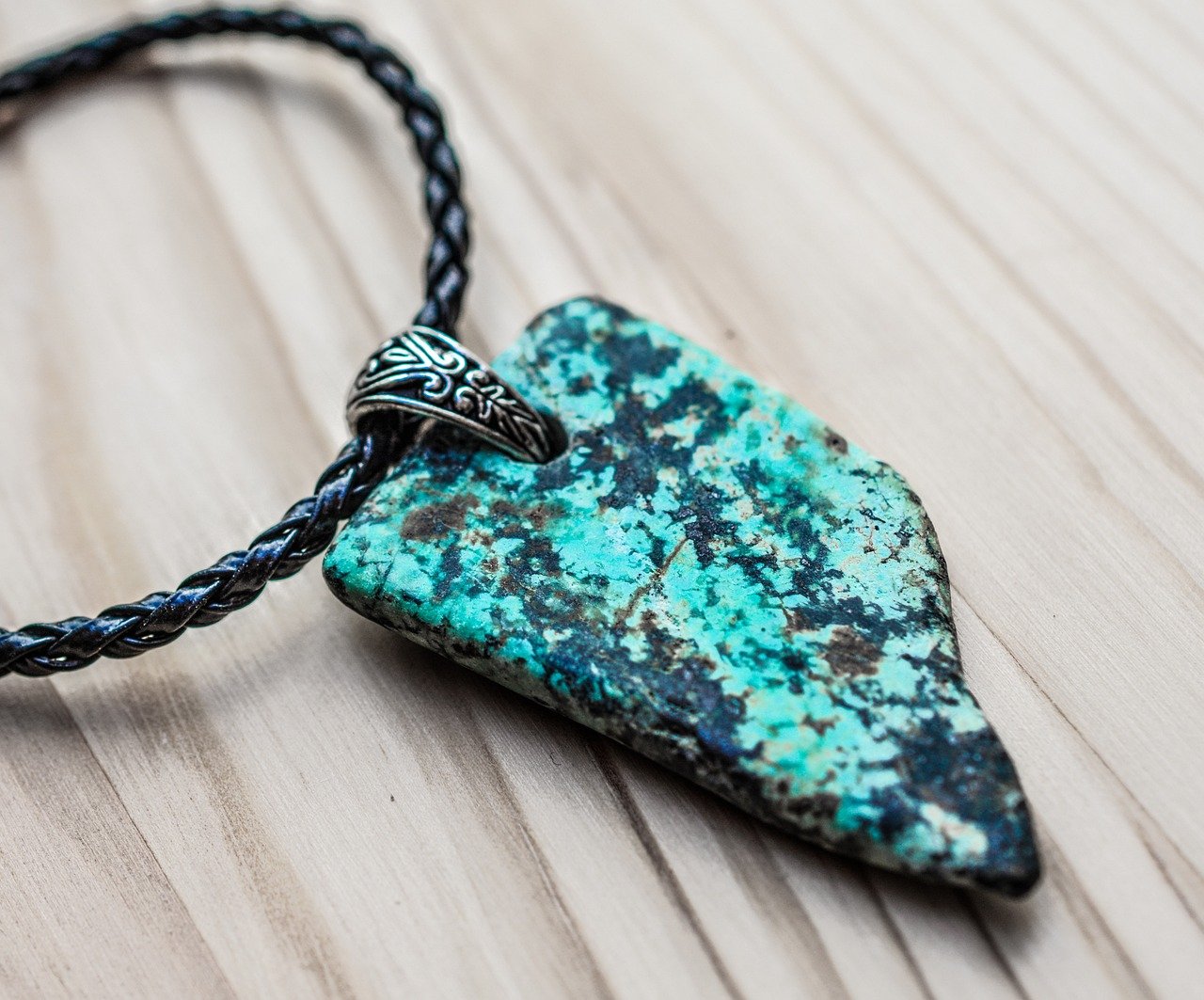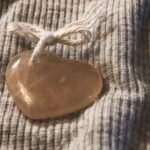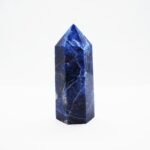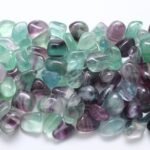What is Turquoise?
Turquoise is a semi‑precious gemstone composed of hydrous phosphate of copper and aluminum, admired for its striking blue to green hues. This vivid stone has been treasured across cultures Egyptian, Persian, Native American for its beauty and spiritual resonance. Known as a symbol of protection, wisdom, and inner peace, turquoise is often used in jewelry and talismans. Its distinctive color and metaphysical associations make it an enduring favorite among both gem enthusiasts and healing practitioners.

History of Turquoise
Cultures like the ancient Egyptians, Persians, and Native Americans heralded turquoise as a sacred stone for spiritual and ceremonial use. The name “turquoise” derives from the French turquois, meaning “Turkish,” in reference to Turkish trade routes that introduced the stone to Europe. For centuries, artisans and shamans carved it into amulets and jewelry believed to protect travelers and promote good fortune. Its timeless allure links rich cultural legacy with contemporary interest in holistic wellness.
Benefits & Properties of Turquoise
Turquoise stone offers a blend of physical, emotional, and spiritual benefits. Believers say it helps balance emotions, promote honest communication, and attract loving, stable relationships. Its calming energy is often used to soothe anxiety and encourage mental clarity. Many people wear turquoise jewelry or carry turquoise stones in daily life to harness these supportive properties, making it both a fashionable and spiritually purposeful gem.
What Colors Can Turquoise Stones Display?
Turquoise ranges from sky blue and robin’s egg tones to deep teal and forest green, often traced with a dark matrix pattern. These natural veining features result from mica, iron, or other mineral inclusions and add character to each stone. High‑quality specimens with vibrant blue tones and minimal webbing are rare and highly valued. The mix of hues and patterns makes turquoise uniquely beautiful and collectible.
Types of Turquoise
Turquoise varieties include Persian turquoise (brilliant blue with minimal matrix), Sleeping Beauty (Arizona’s vivid light blue), and Kingman turquoise, prized for its unique blue‑green shades and intricate veining. African blue turquoise and batu blue lace agate may be similar in appearance but differ mineralogically. Each type brings distinct patterns and metaphysical energy, making selection a personal and meaningful experience.
Natural Turquoise
Natural turquoise refers to untreated, unenhanced turquoise that comes straight from the earth with no chemical stabilizers or color enhancements. This type is rare and highly valuable due to its purity and natural beauty. Its color ranges from pale sky blue to deep green, depending on its copper and iron content. Natural turquoise is relatively soft and porous, making it more fragile and less common in commercial jewelry. Gem collectors and metaphysical users highly prize this form for its authenticity and strong healing energy.
Persian Turquoise
Persian Turquoise is among the most prized types, known for its intense sky-blue color and minimal veining or matrix. Mined in Iran (formerly Persia), this variety has been valued for centuries for its vibrant hue and high quality. Its smooth and uniform appearance makes it a favorite for fine jewelry and royal adornments. Authentic Persian turquoise is rare and can command high prices in the gemstone market.
Sleeping Beauty Turquoise
Hailing from the Sleeping Beauty Mine in Arizona, this type of turquoise features a clear, light blue tone with little to no matrix. Sleeping Beauty Turquoise is popular in Southwestern and Native American jewelry due to its clean, vibrant look. Though the mine closed in 2012, stones from this source remain highly sought-after by collectors and artisans.
Kingman Turquoise
Kingman Turquoise, found in Arizona’s Kingman Mine, showcases a range of blue hues from pale to deep blue with a distinctive black or brown matrix. It’s one of the oldest known turquoise mines in the U.S. and continues to produce high-quality stones. The spiderweb matrix pattern often seen in Kingman turquoise adds to its appeal and uniqueness.
Chinese Turquoise
Mined in various regions of China, Chinese Turquoise is widely available and comes in many shades, including green, blue, and teal. It often has a noticeable matrix and is typically stabilized to improve durability. Due to its availability, Chinese turquoise is often more affordable, making it a good choice for beginners and casual jewelry enthusiasts.
Bisbee Turquoise
Bisbee Turquoise, mined in Arizona’s famous Bisbee Mine, stands out for its rich blue color and signature chocolate-brown matrix. Collectors prize it as one of the most valuable types of American turquoise. Since the mine has closed, these rare stones have become especially sought after in vintage and artisan jewelry.
Royston Turquoise
Royston Turquoise, mined in Nevada, is easily recognized by its striking color combinations of green, blue, and golden-brown matrix. Each stone is unique, with vivid color zoning that makes it a favorite for bold, statement pieces. It’s one of the few varieties still actively mined today in the U.S.
Morenci Turquoise
Coming from southeastern Arizona, Morenci Turquoise is known for its high-grade, vibrant blue color and shiny pyrite inclusions that resemble silver. This eye-catching stone is rare due to the mine’s closure, and its metallic flecks give it a distinctive, collectible appeal.
Tibetan Turquoise
Tibetan turquoise holds deep spiritual and healing value in Himalayan cultures. Mined from high-altitude regions, it typically shows greenish-blue shades with a dark web-like matrix. Artisans often use it in tribal and ethnic jewelry, where its raw, earthy look pairs with powerful metaphysical meaning.
Number Eight Turquoise
Named after the Number Eight Mine in Nevada, this turquoise features a rich golden-brown to red matrix with bright blue to green-blue color. Number Eight Turquoise is a collector’s gem due to its distinct matrix and the mine’s limited production. It’s often used in high-end Southwestern jewelry.
White Buffalo (Often Mistaken for Turquoise)
Though not technically turquoise, White Buffalo is often marketed as such due to its similar appearance. Found in Nevada, it has a white body color with black or brown veining. It’s a popular alternative in jewelry for those seeking the aesthetic of turquoise without the traditional blue or green hues.
The Symbolism and Spiritual Properties of Turquoise Stone
Turquoise gemstones carry deep spiritual meaning and have played a sacred role in cultures around the world. Known as a stone of protection, turquoise helps shield the wearer from negative energy and emotional harm. Spiritually, it promotes inner peace, emotional balance, and clear communication qualities that make it a popular choice in healing practices. Ancient civilizations like the Egyptians, Persians, and Native Americans revered turquoise as a bridge between heaven and earth. Its calming blue-green hue enhances intuition, attracts wisdom, and supports spiritual growth, making natural turquoise more than just a beautiful gem.
Colors of Turquoise – More Than Just Blue
While most people picture turquoise gemstones as sky blue, this vibrant mineral comes in a stunning variety of shades. From deep green turquoise to bluish-green and even yellowish tones, its color depends on the levels of copper and iron within the stone. High-copper content produces the classic robin’s egg blue, while more iron yields greenish turquoise. Rarely, turquoise may display a matrix of black, brown, or gold veins, enhancing its natural character. Each color variation holds its own charm and energy, making natural turquoise a uniquely expressive gemstone for both collectors and jewelry lovers.
Does Turquoise Make a Good Jewelry Stone?
Yes, turquoise is prized in jewelry for its vibrant color and cultural significance. However, because it rates around 5–6 on the Mohs scale, it is softer than other gems and requires thoughtful handling. It looks stunning in rings, bracelets, and statement necklaces, especially when set in silver or gold. Proper care and maintenance help preserve the stone’s luster and color, ensuring it remains a cherished piece for years.
How Durable Is Turquoise Jewelry?
While turquoise is moderately soft, quality pieces prove durable when treated and worn with care. Many jewelers use stabilized turquoise treated to resist cracking and fading to enhance longevity. Matrix patterns can influence strength, but proper setting and occasional polishing keep it intact. By avoiding harsh chemicals and storing pieces separately, turquoise jewelry remains vibrant and structurally sound over time.
How Do Matrix Patterns Impact Durability?
The natural matrix veins or webbing inside turquoise adds visual appeal but can also introduce weak points. Stones with heavy matrix may be more fragile, while dense, compact forms tend to hold up better in everyday wear. Turquoise with stable, clean veining is ideal for rings and bracelets. Many collectors and jewelers select stones with attractive matrix that also balance hardness and visual beauty.
How to Identify Genuine Turquoise
To distinguish real turquoise, look for a stone with natural color variation and matrix that aren’t overly uniform. Avoid stones that appear painted or too glossy these may be dyed or synthetic. Testers may use a magnifier to spot inconsistencies or surface dye. Authentic turquoise often feels cool, may leave a faint powder residue when scratched, and shows variations in depth of tone. Purchasing from reputable sellers with certification helps ensure authenticity.
Conclusion – Why Turquoise Gemstones Will Always Remain in Style
From ancient mystics to modern jewelers, turquoise gemstones have maintained an undeniable allure. Their rich history, striking beauty, and profound symbolism continue to inspire people worldwide. Whether worn as a spiritual talisman, a fashion statement, or collected for investment, turquoise will forever remain a treasured gem in the world of crystals and minerals. As trends come and go, the timeless charm of natural real turquoise ensures its place as one of the most beloved gemstones across generations.
FAQs About Turquoise Gems:
Turquoise is a blue-green gemstone formed from copper and aluminum minerals in arid climates. It’s prized for its color and spiritual symbolism.
Yes, turquoise is the traditional December birthstone, symbolizing protection, luck, and calm energy.
Real turquoise has a natural texture and matrix. Fakes are often dyed howlite or plastic with uniform color.
Types include Persian, Sleeping Beauty, Kingman, Bisbee, Tibetan, and more each with unique color and origin.
Stabilization strengthens soft turquoise and helps retain color, making it suitable for daily wear.
Turquoise symbolizes healing, wisdom, protection, and emotional balance across many cultures.
Yes, but untreated turquoise needs care. Stabilized turquoise is more durable for everyday jewelry.
Yes, it can range from green, yellow, pink, white to even black depending on its mineral content.
Yes, especially untreated stones from rare mines like Sleeping Beauty. Value depends on color, hardness, and origin.
Howlite is a white stone dyed to mimic turquoise but lacks its value, hardness, and energy.
Yes, natural turquoise can darken from exposure to oils, sunlight, or moisture.
Conclusion: The Timeless Allure of Turquoise
Turquoise remains one of the most cherished gemstones, valued for its vivid color, deep symbolism, and rich history. From ancient amulets to modern jewelry, it brings healing, protection, and emotional balance. Whether you’re buying natural turquoise, exploring its many types, or connecting with its spiritual energy, this gem offers lasting beauty and meaning. With the right care, turquoise jewelry will keep its vibrant charm and positive energy for years to come. Let turquoise inspire clarity, creativity, and calm in your life.







